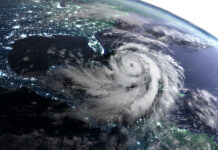
After a calm August, a tropical storm is forming in the Atlantic, and it’s expected to become this season’s first hurricane.
The National Oceanic and Atmospheric Administration (NOAA) announced in early August that an “above normal” hurricane season was approaching. While (current) Tropical Storm Danielle is expected to remain in the Atlantic Ocean, there are still three more months of hurricane season left. If they haven’t already, facility managers need to ensure they have an up-to-date plan in place to react quickly and effectively in case a hurricane forms nearby. Having leak diverters available in case your roof leaks, trimming large trees and shrubs away from buildings, double checking to be sure sub pumps and generators are working efficiently are a few ways to prepare for extreme weather.
Another consideration is the safety of your elevator system. To help address elevator safety during hurricanes, Jakub Glowacki, Director of Repairs at Schindler Elevator Corporation, spoke with Facility Executive to share some of his tips for facility mangers.
What can facility managers do before a storm to help keep people and property safe?
There are quite a few things building managers can do before a storm. Long-term, consider upgrades to the elevators that will help once a storm arrives, as lead times can be long. Surge Protection and Emergency Power systems can be useful upgrades for the building as a whole rather than just the elevator system. Ensure ventilation openings, windows and doors are able to withstand weather events, and install weather stripping and/or splash guards where appropriate to prevent leakage.
Every year, Schindler distributes and posts a helpful guide.
As storms bring heavier and more constant rainfall, how should buildings handle the increased risk of flooding?
With respect to elevators, the best solution is a system for liquid intrusion detection. With a LID system, a float switch mounted in the elevator pit detects liquid intrusion. Once the float switch is initiated, an immediate signal is sent to the controller to move the elevator to a “safe landing.” This allows the elevator to quickly move away from the liquid, and can help limit damage to the elevator.
What protections should be in place to keep riders safe during extreme weather?
Liquid Intrusion Detection ensures that the elevator reacts intelligently to flooding, and prevents riders from being entrapped in an elevator. Surge Protection and Anti-Entrapment Systems offer additional protection to riders: Surge Protection can help prevent damage to elevator components from power surges and lighting strikes, thus preventing passenger entrapment. An Anti-Entrapment System allows for the automatic release of riders from an elevator in case of a power failure during a weather event.
What role does IoT and smart tech play in elevator safety?
Connected elevators as well as other building systems can help optimize preventative maintenance before the storm, and monitor the status of systems during the storm. For elevators in particular, IoT will provide real-time updates on the status and location of elevators throughout the entire building, and allow that status to be monitored through web and phone applications.
This year is the 10th anniversary of Hurricane Sandy. What did elevator companies takeaway from that storm?
I believe Hurricane Sandy as well as other weather events in the last few years have encouraged elevator companies to be more proactive about offering product solutions that help mitigate passenger entrapment and equipment damage, as well as making elevator companies more proficient at dealing with the fallout from these weather events. “Storm Seasonal” products exist today as standard product solutions that can be easily retrofitted to existing elevators at a reasonable cost. Similarly, we have standard procedures in place to deal with water damage in phases, with an approach that helps bring elevators back into service swiftly and safely, but also deals with potential long-term damage, all while helping in dealing with insurance companies.



















![[VIDEO] Collect Asset Data at the Speed of Walking a Building](https://facilityexecutive.com/wp-content/uploads/2024/02/maxresdefault-324x160.jpg)